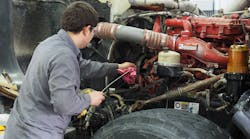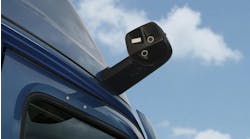As everyone in the industry should know by now, two new truck engine oil blends are due to hit the market on Dec. 1 this year – blends meeting Proposed Category 11 or “PC-11” standards finalized back in February under the auspices of the American Petroleum Institute (API).
The introduction of these two new engine oils, now known as CK-4 and FA-4, represents the largest change in oil specifications in a generation, so for some insight into how those oils may – or may not – affect heavy truck engines, Fleet Owner talked to Steve Haffner, North American market manager at Infineum USA L.P.
Overall, when is it best to use FA-4 vs. CK-4? What conditions duty cycles need to be considered?
It’s best to follow the recommendation of your engine manufacturer regarding when to use CK-4 or FA-4.
Generally, CK-4 oils can be used in both new and old engines. But FA-4 oils may have some limited backwards compatibility, but again, fleets will need to check with their engine manufacturer as API language does not allow any backwards compatibility for FA-4 oils.
While FA-4 will maximize fuel economy in the newest engines, we know that off-road diesel engine manufacturers are not planning to recommend FA-4 oils in the near-term and will instead recommend CK-4 or [the current] CJ-4 engine oil.
Is engine displacement a factor in selecting what oil to use? Say in the case of 11 liter versus 15 liter for example?
As of today, engine size/horsepower is not considered a factor in the application of the new oils. But generally speaking, larger engines used in off-road applications will recommend CK-4 oils.
If by accident FA-4 gets mixed with CK-4 in the engine will there be problems?
In applications calling for FA-4, the use of CK-4 will not cause a problem. The reverse situation would not be true if an FA-4 oil gets mixed with CK-4 engine oil in an application that does not allow FA-4. But we would not expect any impacts if use was only for a short period of time.
One big question as you noted before is “backwards compatibility” for the new oils. How far back right now does the industry think CK-4 can be used? Back to 2010 engines or farther than that?
In North America, CK-4 engine oils are expected to be fully backward compatible in the same SAE viscosity grades recommended for current and older diesel engines.
Will CK-4 basically replace the current CJ-4 blend?
CK-4 oils will provide enhanced engine protection and be used in applications which called for CJ-4, CI-4 PLUS, CI-4 and CH-4.
Right now, FA-4 seems as if it won’t be backwards compatible. Think that will hold true going forward?
This is still a large unknown as noted. API user language does not allow any back serviceability. No OEM as of today has issued any service bulletins allowing use of the new FA-4 oils in older engines and many are even still evaluating use of FA-4 in newer applications.
The new oils in general sport lower viscosity than ‘older’ oils. Is it safe to use lower viscosity oil in older engines? Would using such oils actually improve performance and maybe fuel economy too?
Owners should again check with the engine manufacturer to ensure their engine is compatible with the lower viscosity oil they are considering. The most conservative approach is to simply use the SAE viscosity grade that is recommended in your owner’s manual for your diesel engine.
That said, since around 2012, many OEMs have allowed and even factory-fill engines with SAE 10W-30 CJ-4 oils. This would mean that an SAE 10W-30 CK-4 engine oil would be a nice fit for many fleets with both older and newer engines.
If further fuel economy is desired and the engine manufacturer says FA-4 SAE 10W-30 oils are compatible with the engine, then around 0.5% additional fuel economy could be realized depending on application.




